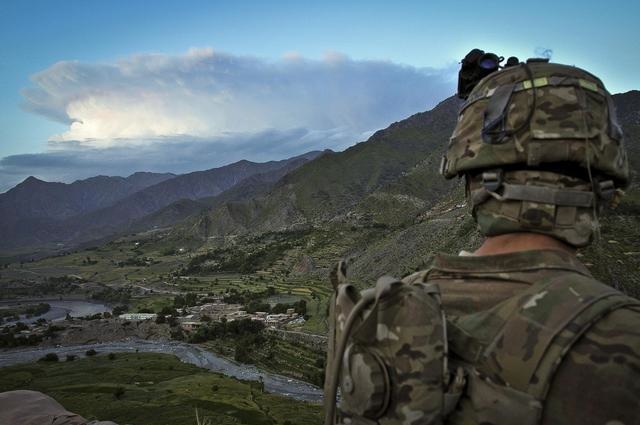
A U.S. soldier on watch in Afghanistan's Kunar province, not far from Saturday's helicopter attack on Pakistani forces / Army photo by Mark Burrell
There is no well-defined border between Afghanistan and Pakistan, and – all too often amid the fog of war and firefights – there is no well-defined difference between the Pakistani military and anti-American insurgents crowded along that rugged frontier. That’s apparently why a U.S. air attack early Saturday killed at least 25 Pakistani troops whom the American forces mistook for Taliban militants.
It marked the latest – and most deadly – downturn in the worsening U.S.-Pakistan relationship. The decline began in May, when the U.S. killed Osama bin Laden in the heart of Pakistan without letting Pakistan know beforehand. It fell further this past week when Husain Haqqani, Islamabad’s ambassador to Washington, resigned. He had been linked to a missive seeking help from the U.S. military to thwart a possible coup in Pakistan led by officers infuriated by the bin Laden raid (Haqanni has denied any complicity).
This is the chronic and oozing pus-filled wound of the U.S. war in Afghanistan.
Despite tribal loyalties that go back a thousand years, the West sees the border between Afghanistan and Pakistan as a nearly-neat frontier, capable of being policed, more or less. But the Pashtun people who fuel the Taliban have ignored that border for centuries, and will continue to do so. That seems to create a challenge well beyond the ability of the U.S., NATO, or any outside power, to surmount.
The Taliban know they can hit targets before running back to sanctuaries. It’s a technique that cuts down on their chances of being attacked, and boosts the possibility that well-armed U.S. or Pakistani forces will attack one another in mistaken retaliation. To complicate matters further, Afghan Taliban find sanctuary in their home country before bolting across the border to strike Pakistani troops; Pakistani Taliban – a separate group — reverse the process in their attacks on U.S. and Afghan forces. “We want a very clear message to the insurgents on both sides of the border that we are going to fight you and we are going to seek you in your safe havens, whether you’re on the Afghan side or the Pakistani side,” Secretary of State Hillary Clinton said in Kabul last month. “They must be dealt with.”
Reports from the region said Saturday’s 2 a.m. attack apparently came from both helicopters and fixed-wing aircraft. It took place at two Pakistani army checkpoints near the village of Salala, along the country’s northwest border with Afghanistan’s Kunar province. About 40 Pakistani troops were based at the posts, which the Pakistani military had recently set up to keep the Afghan-based Taliban in Afghanistan.
The attack marks the most lethal U.S. strike on Pakistani forces since the U.S. invaded Afghanistan a decade ago. Until Saturday, the most deadly strike happened in June 2008, when 11 Pakistani paramilitary troops were killed after the U.S. mistook them for Taliban fighters (of course, early reports often end up with key elements missing or mistaken, so confirmation remains vital before trying to figure out what went wrong).
The Haqanni network (unrelated to Pakistan’s recently-departed ambassador) is perhaps the Taliban’s most fierce fighting force. It has regularly lobbed mortar and rocket fire at U.S. troops in Afghanistan from safe havens in Pakistan. The Pentagon’s congressional-mandated semi-annual report on progress in Afghanistan noted the continuing problem last month. “The security situation in Regional Command East…remains tenuous,” it said. “Cross-border incidents have risen during the reporting period as a result of the sanctuary and support that the insurgency receives from Pakistan.”
Yet, a top Pentagon officer said Tuesday that things are actually improving:
…about the cross-border fires, that has actually tapered somewhat in the past several weeks. And in fact we’ve had some very good cases in the last three weeks of the Pak-mil coordinating with us to respond against those cross-border fires. And that coordination occurs with every event that happens. I’d say in the last three weeks we’re probably averaging three to four cross-border firing incidents a week. Not all of those are confirmed to come from Haqqani network operators, but the majority do come from the area from which they normally operate.
…Army Major General Daniel Allyn, the top U.S. commander in eastern Afghanistan, told reporters two days before Thanksgiving.
U.S. Marine Gen. John Allen, commander of U.S. and NATO forces in Afghanistan, said the apparently mistaken strike “has my highest personal attention and my commitment to thoroughly investigate it to determine the facts.” In a statement, the Pakistani foreign ministry said the attack represented “a serious transgression of oft-conveyed red lines, and could have serious repercussions” for Pakistan’s continued cooperation with U.S. forces in Afghanistan.
In protest, Pakistan ordered the CIA to stop flying militant-killing drone flights from Shamsi air base, in the northern part of the country. It also shut down the two major overland supply routes from Pakistan to Afghanistan, at Torkham along the Khyber Pass in the country’s north, and at Chaman in the south. They’re key arteries for fuel, food and other supplies flowing into Afghanistan for U.S. troops.
Think of it as the Torkham tourniquet, which has been regularly applied to this festering wound along the 1,640-mile (2,640-km) Durand Line that defines the Af-Pak frontier. Islamabad has done this before, and will likely do it again, after it lifts its shutdown order in a few days. It’s a practice ill-suited to a festering wound, but one that makes the patient feel better, even as it does nothing to improve long-term chances of survival.


